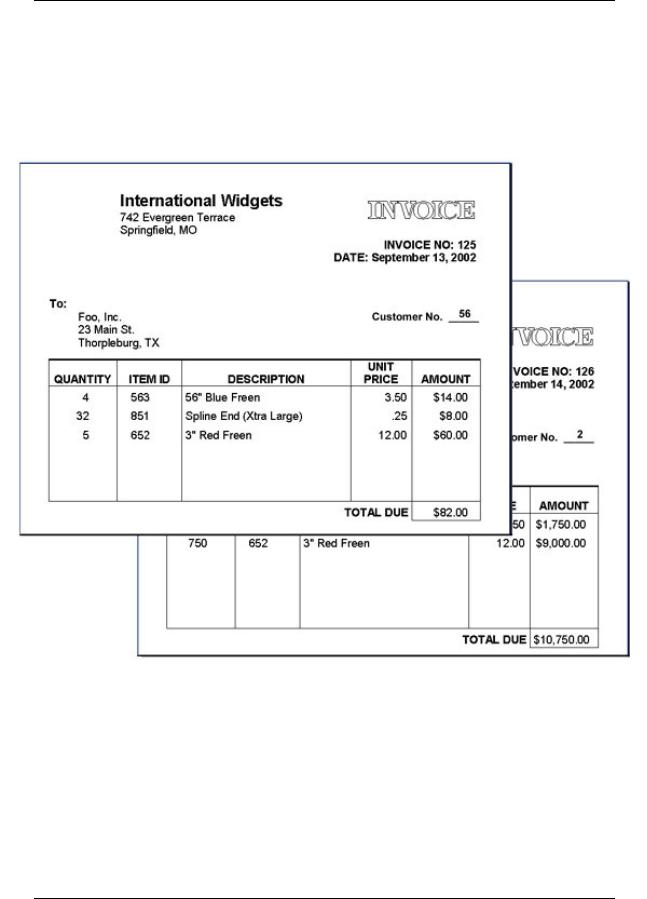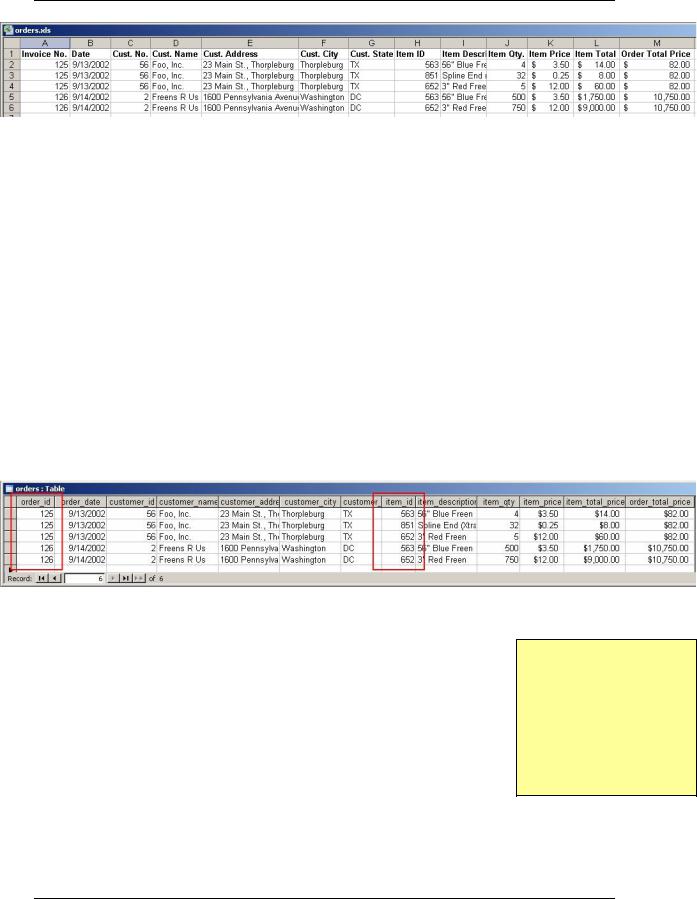
BD_Normalization_nf3_tutorial
.pdfThe 3 Normal Forms:
A Tutorial
by Fred Coulson
Copyright © Fred Coulson 2007 (last revised August 26, 2013)
This tutorial may be freely copied and distributed, providing appropriate attribution to the author is given.
Inquiries may be directed to http://phlonx.com/contact
Downloaded from http://phlonx.com/resources/nf3/

|
Table of Contents |
Table of Contents |
|
TABLE OF CONTENTS ....................................................................................... |
1 |
INTRODUCTION .................................................................................................. |
2 |
THE PROBLEM: |
|
KEEPING TRACK OF A STACK OF INVOICES ................................................. |
3 |
FIRST NORMAL FORM: |
|
NO REPEATING ELEMENTS OR GROUPS OF ELEMENTS ............................. |
5 |
SECOND NORMAL FORM: |
|
NO PARTIAL DEPENDENCIES ON A CONCATENATED KEY.......................... |
8 |
SECOND NORMAL FORM: |
|
PHASE II ............................................................................................................ |
13 |
THIRD NORMAL FORM: |
|
NO DEPENDENCIES ON NON-KEY ATTRIBUTES.......................................... |
16 |
REFERENCES FOR FURTHER READING ....................................................... |
19 |
3 Normal Forms Tutorial |
http://phlonx.com/resources/nf3/ |
1

Introduction
Introduction
This is meant to be a brief tutorial aimed at beginners who want to get a conceptual grasp on the database normalization process. I find it difficult to visualize these concepts using words alone, so I shall rely as much as possible upon pictures and diagrams.
To demonstrate the main principles involved, we will take the classic example of an Invoice and level it to the Third Normal Form. We will also construct an Entity Relationship Diagram (ERD) of the database as we go.
Important Note: This is not a description of how you would actually design and implement a database. The sample database screenshots are not meant to be taken literally, but merely as visual aids to show how the raw data gets shuffled about as the table structure becomes increasingly normalized.
Purists and academics may not be interested in this treatment. I will not cover issues such as the benefits and drawbacks of normalization. For those who wish to pursue the matter in greater depth, a list of references for further reading is provided at the end.
For the most part, the first three normal forms are common sense. When people sit down to design a database, they often already have a partially-normalized structure in mind—normalization is a natural way of perceiving relationships between data and no special skill in mathematics or set theory is required.
In fact, whereas normalization itself is intuitive, it usually takes quite a bit of advanced skill to recognize when it is appropriate to de-normalize a database (that is, remove the natural efficient relationships that a normalized data structure provides). Denormalization is a fairly common task, but it is beyond the scope of this presentation.
To begin: First, memorize the 3 normal forms so that you can recite them in your sleep. The meaning will become clear as we go. Just memorize them for now:
1.No repeating elements or groups of elements
2.No partial dependencies on a concatenated key
3.No dependencies on non-key attributes
3 Normal Forms Tutorial |
http://phlonx.com/resources/nf3/ |
2

The Problem:
Keeping Track of a Stack of Invoices
The Problem:
Keeping Track of a Stack of Invoices
Consider a typical invoice (Figure A).
Figure A: Invoice
Every piece of information you see here is important. How can we capture this information in a database?
Those of us who have an ordered mind but aren't quite aware of relational databases might decide to use a spreadsheet, such as Microsoft Excel.
3 Normal Forms Tutorial |
http://phlonx.com/resources/nf3/ |
3

The Problem:
Keeping Track of a Stack of Invoices
Figure A-1: orders spreadsheet
This isn't a bad approach, since it records every purchase made by every customer. But what if you start to ask complicated questions, such as:
•How many 3" Red Freens did Freens R Us order in 2002?
•What are total sales of 56" Blue Freens in the state of Texas?
•What items were sold on July 14, 2003?
As your collection of invoices grows it becomes increasingly difficult to ask the spreadsheet these questions. In an attempt to put the data into a state where we can reasonably expect to answer such questions, we begin the normalization process.
3 Normal Forms Tutorial |
http://phlonx.com/resources/nf3/ |
4

First Normal Form:
No Repeating Elements or Groups of Elements
First Normal Form:
No Repeating Elements or Groups of Elements
Take a look at rows 2, 3 and 4 on the spreadsheet in Figure A-1. These represent all the data we have for a single invoice (Invoice #125).
In database lingo, this group of rows is referred to as a single database row. Never mind the fact that one database row is made up here of three spreadsheet rows: It's an unfortunate ambiguity of language. Academic database theoreticians have a special word that helps a bit with the ambiguity: they refer to the "thing" encapsulated by rows 2, 3 and 4 as a tuple (pronounced tu'ple or too'ple). We're not going to use that word here (and if you're lucky, you'll never hear it again for the rest of your database career). Here, we will refer to this thing as a row.
So, First Normal Form (NF1) wants us to get rid of repeating elements. What are those?
Again we turn our attention to the first invoice (#125) in Figure A-1. Cells H2, H3, and H4 contain a list of Item ID numbers. This is a column within our first database row. Similarly, I2-I4 constitute a single column; same with J2-J4, K2K4, L2-L4, and M2-M4. Database columns are sometimes referred to as attributes (rows/columns are the same as tuples/attributes).
You will notice that each of these columns contains a list of values. It is precisely these lists that NF1 objects to: NF1 abhors lists or arrays within a single database column. NF1 craves atomicity: the indivisibility of an attribute into similar parts.
Therefore it is clear that we have to do something about the repeating item information data within the row for Invoice #125. On Figure A-1, that is the following cells:
•H2 through M2
•H3 through M3
•H4 through M4
Similar (though not necessarily identical) data repeats within Invoice #125's row. We can satisfy NF1's need for atomicity quite simply: by separating each item in these lists into its own row, as in Figure A-2.
3 Normal Forms Tutorial |
http://phlonx.com/resources/nf3/ |
5

First Normal Form:
No Repeating Elements or Groups of Elements
Figure A-2: flattened orders spreadsheet
I can hear everyone objecting: We were trying to reduce the amount of duplication, and here we have introduced more! Just look at all that duplicated customer data!
Don't worry. The kind of duplication that we introduce at this stage will be addressed when we get to the Third Normal Form.
We have actually only told half the story of NF1. Strictly speaking, NF1 addresses two issues:
1.A row of data cannot contain repeating groups of similar data (atomicity)
2.Each row of data must have a unique identifier (or Primary Key)
We have already dealt with atomicity. But to make the point about Primary Keys, we shall bid farewell to the spreadsheet and move our data into a relational database management system (RDBMS). Here we shall use Microsoft Access to create the orders table, as in Figure B:
Figure B: orders table
This looks pretty much the same as the spreadsheet, but the difference is that within an RDBMS we can identify a primary key. A primary key is
a column (or group of columns) that uniquely identifies each row.
As you can see from Figure B, there is no single column that uniquely identifies each row. However, if we put a number of columns together, we can satisfy this requirement.
The two columns that together uniquely identify each row are order_id and item_id: no two rows have the same combination of order_id and item_id. Therefore, together they qualify to be
used as the table's primary key. Even though they are in two different table columns, they are treated as a single thing. We call them concatenated.
3 Normal Forms Tutorial |
http://phlonx.com/resources/nf3/ |
6

First Normal Form:
No Repeating Elements or Groups of Elements
The underlying structure of the orders table can |
Figure C: orders table structure |
be represented as Figure C. |
|
We identify the columns that make up the |
|
primary key with the PK notation. Figure C is the |
|
beginning of our Entity Relationship Diagram |
|
(or ERD). |
|
Our database schema now satisfies the two |
|
requirements of First Normal Form: atomicity |
|
and uniqueness. Thus it fulfills the most basic |
|
criterion of a relational database. |
|
What's next? |
|
|
|
3 Normal Forms Tutorial |
http://phlonx.com/resources/nf3/ |
7

Second Normal Form:
No Partial Dependencies on a Concatenated Key
Second Normal Form:
No Partial Dependencies on a Concatenated Key
Next we test each table for partial dependencies on a concatenated key. This means that for a table that has a concatenated primary key, each column in the table that is not part of the primary key must depend upon the entire concatenated key for its existence. If any column only depends upon one part of the concatenated key, then we say that the entire table has failed Second Normal Form and we must create another table to rectify the failure.
Still not clear? To try and understand this, let's take apart the orders table column by column. For each column we will ask the question,
Can this column exist without one or the other part of the concatenated primary key?
If the answer is "yes" — even once — then the table fails Second Normal Form.
Refer to Figure C again to remind us of the orders |
Figure C: orders table structure |
|
|
table structure. |
|
First, recall the meaning of the two columns in the |
|
primary key: |
|
•order_id identifies the invoice that this item comes from.
•item_id is the inventory item's unique identifier. You can think of it as a part number, inventory control number, SKU, or UPC code.
We don't analyze these columns (since they are part of the primary key). Now consider the remaining columns...
order_date is the date on which the order was made. Obviously it relies on order_id; an order date has to have an order, otherwise it is only a date. But can an order date exist without an item_id?
The short answer is yes: order_date relies on order_id, not item_id. Some of you might object, thinking that this means you could have a dated order with no items (an empty invoice, in effect). But this is not what we are saying at all: All we are trying to establish here is whether a particular order on a particular date relies on a particular item. Clearly, it does not. The problem of how to prevent empty
3 Normal Forms Tutorial |
http://phlonx.com/resources/nf3/ |
8

Second Normal Form:
No Partial Dependencies on a Concatenated Key
orders falls under a discussion of "business rules" and could be resolved using check constraints or application logic; it is not an issue for Normalization to solve.
Therefore: order_date fails Second Normal Form.
But let's continue with testing the other columns. We have to find all the columns that fail the test, and then we do something special with them.
customer_id is the ID number of the customer who placed the order. Does it rely on order_id? No: a customer can exist without placing any orders. Does it rely on item_id? No: for the same reason. This is interesting: customer_id (along with the rest of the customer_* columns) does not rely on either member of the primary key. What do we do with these columns?
We don't have to worry about them until we get to Third Normal Form. We mark them as "unknown" for now. 

item_description is the next column that is not itself part of the primary key. This is the plain-language description of the inventory item. Obviously it relies on item_id. But can it exist without an order_id?
Yes! An inventory item (together with its "description") could sit on a warehouse shelf forever, and never be purchased... It can exist independent of an order. item_description fails the test. 
item_qty refers to the number of items purchased on a particular invoice. Can this quantity exist without an item_id? Impossible: we cannot talk about the "amount of nothing" (at least not in database design). Can the quantity exist without an order_id? No: a quantity that is purchased with an invoice is meaningless without an invoice. So this column does not violate Second Normal Form: item_qty depends on both parts of our concatenated primary key. 
item_price is a tricky one. At first glance it seems similar to item_description: the price of an item has nothing to do with the order it is part of, it depends only on the item_id and thus violates Second Normal Form. But let's think a little bit about that. What happens if the price of an item changes? What if you need to keep track of the changing item price over time?
A common-sense thing to do would be to regard the item price as dependent on both the item and the order. Whether this solution is appropriate or not would depend on the needs of the business you are modeling. The point is that this is not a question that can be addressed by the Normalization process alone; once again, we have a matter that falls under the discussion of business rules. For the sake of simplicity I have chosen to create this tutorial in a world where prices never change, and within this static and rarified world, item_price fails Second Normal Form. 
3 Normal Forms Tutorial http://phlonx.com/resources/nf3/
9
